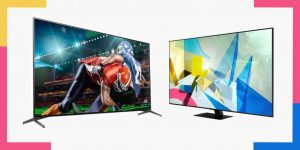Top 10 Plasma Television Business Guides
Top 10 Plasma Television Business guides. Are you interested in going into the Plasma television business but do not know how to go about it? This post will give you details of all that is needed to be known.

Plasma Television Business
Getting tv in Nigeria nowadays is a difficult process, as many individuals are confronted with the problem of deciding which type and manufacturer would best suit them among the many brands that competitors in the market on a regular basis. Plasma, LED, OLED, and Smart TVs are quite costly since they are the best in terms of features and general TV functionality, and they are still the most highly rated televisions in Nigeria and other parts of the globe.
As you might imagine, the expense of a television increases as the screen size increases. Nevertheless, screen resolution may not be the only factor that influences price. The price is influenced by the screen resolution, access ports, and other features such as 3D or Smart capabilities.
For comparison, TVs from UKA, Hisense, Bruhm, and Polystar are less expensive, but LG and Samsung TVs are much more expensive but come with better service and quality.
See also: Top 10 ways to attract more customers to your business
What is the best brand of TV?
Although there are many major brands, designers usually only suggest six or seven to viewers. Samsung, LG, Sony, Vizio, Panasonic, TCL, Philips, and Hisense are among them. The best Tv brands include the following:
1. Sony Master Series
The Sony Master Series A9G OLED is a full HD monitor that actually sounds fantastic and provides the finest quality we’ve seen on screen this year. This magnificent TV features an OLED panel with outstanding colour, HDR compatibility with brilliant sparks and deep blacks, and pixel-perfect contrast and illumination. These and more features work together to make this TV a truly outstanding SMART TV. This TV is on my top list of best TVs in 2020 because you deserve a SMART television experience this year.
2. LG 50PK790 Television
The LG 50PK790 is the most recent Freeview HD television on the market. It is a 50-inch Plasma TV with an advanced comprehensive A/V system that delivers the most appealing images. The LG 50Pk790 TV is an excellent plasma television that is also reasonably priced. This is a plasma TV that will satisfy the demands of you and your family in 2020.
3. QLED TV Samsung Q90
The Samsung Q90 QLED TV is the industry’s top-quality 4K LCD TV. The television provides excellent image quality. It also includes some shockingly clever capabilities that no one else does, like AMD’s Free Sync for optimal gaming, exclusive Apple TV content, and a sophisticated smart home management panel for all of your connected devices.
4. Panasonic TX-P50S20B TV
Panasonic’s TX-P50S20B TV is the company’s most recent plasma television model. It is a service capabilities television with great features that are meant to enhance your visual effect. Maybe one of the TV’s main attractions is its built-in Freeview HD tuner, which allows users to watch a variety of Freeview HD channels such as BBC, ITV, and E4. This TV offers lifelike images, vivid colours, and remarkable detail. The Panasonic TX-P50S20B also has crisper and smoother motion than comparable plasma televisions.
Things to consider before starting the business
1. The brightness of Plasma Screen Televisions
LCD televisions, as well as some high-end CRT televisions, may be extremely bright. They don’t come close to matching the brightness of plasma screens. Plasma televisions have the ability to show image brightness that is absolutely consistent. Poor-quality displays frequently feature “hot spots” or regions that are excessively bright. Many televisions’ pictures discolour around the edges as they get older. Both distortions have the potential to make visuals on-screen appear strange. A plasma screen television’s transistors evenly light all of the pixels on the screen.
2. Screen size
Imagine when a 50-inch television looked enormous? Screens with displays of 55 and 65 inches are increasingly popular. “Through the close of 2020, 65-inch televisions would have firmly overtaken 55-inch devices as perhaps the most frequent screen size customers see in shops,” says Deirdre Kennedy, general director at Gap Intelligence, a commercial research firm that includes Consumer Reports as a client.
Only a few computer monitors include built-in speakers. Some, on the other hand, have built-in processors on the sides that operate with speakers that may be attached. These loudspeakers are typically low-powered (7 or 8 watts), yet they provide adequate sound.
3. Scan Lines
Once a design is produced on a conventional CRT. All over the back of the screen, an electron beam travels. The process of scanning a picture onto phosphors. The patterns in the photos are scanned by these leaves. This can be seen, particularly on older televisions. Plasma televisions do not use phosphors or electron beams to display images.
4. Screen Shape
Curved screens are common on CRT televisions. As a result, pictures towards the margins have a small distortion. Glare on CRT television displays is also a common cause of issues. Plasma televisions have a completely flat screen. Providing a consistent picture with no edge distortion. A plasma screen television’s flat surface. In addition, compared to standard televisions, it provides for more viewing angles. The problem of screen glare may frequently be solved by coating the plasma screen with a thin layer of plexiglass.
See also: How to start a football viewing centre in Nigeria
5. Colour Levels of Plasma
Widescreen televisions’ visual abilities considerably surpass those of traditional CRT televisions. A flatscreen television is made possible by this strong image capacity. A beautiful piece of home entertainment as well as a valuable tool for photographers and videographers. Up to 16.77 million colours may be shown on a high-quality plasma screen television. The televisions may also display very subtle colour changes. Creating a more realistic image.
6. Wide Viewing Angles
This features a greater camera angle than traditional CRT televisions. Most plasma televisions have a viewing angle of 160 degrees from top to bottom and left to right. This broad viewing angle surpasses that of LCD television screens. Widescreen televisions have a 160-degree viewing angle, allowing users more screen positioning options inside a room. All viewers will be able to see flatscreen monitors in entertainment centres. To be able to observe a larger region more comfortably.
7. Older Aspect Ratios
You might be concerned that pictures with a 4:3 aspect ratio will be incompatible. Plasma screen televisions have a 16:9 aspect ratio. Fortunately, plasma televisions offer two major methods for coping with this inconsistency. In the first example, plasma televisions may display the entirety of a 4:3 picture on the screen. The unused picture space is compensated for by black or grey bars on the sides.
Stretching the picture on a plasma screen television may also display a 4:3 aspect ratio image across the entire screen. This is accomplished by expanding the whole image on a plasma screen television. Also, the stretching should be limited to the image’s side.
8. Video format
Plasma televisions are now providing users with. With some of the most flexibility across a variety of video formats. It can release images using coaxial direction and supervision. Also utilized by digital video recorders and DVD players in the digital S-video input. Most computer systems can send visual signals to plasma screen displays. Plasma TVs are particularly beneficial for professionals that work with a variety of video formats.
9. High Dynamic Range (HDR)
HDR does all of this by boosting the contrast between a TV’s brightest whites and deepest blacks. That’s where the term “dynamic range” originates from. HDR TVs often generate more bright, diversified colours than conventional televisions. This is because HDR is frequently used in conjunction with “broad colour gamut.” WCG-enabled HDTVs can show up to a billion colours, compared to 17 million on standard HDTVs. Providing your TV with a bigger colouring book to play with which is like allowing your kids a bigger box of crayons.
10. The Ins and Outs of Resolution
Since such image quality is 1920×1080, a standard high-definition (HD) set is sometimes known as a 1080p model. That implies that has 1,920 horizontal pixels and 1,080 vertical pixels, for a total of about 2 million pixels. Pixels, known for “picture elements,” are the comparatively tiny dots that build up the picture on your television.
See also: 10 Steps to start a video game business in Nigeria
Conclusion
Despite Plasma TVs are significantly lighter in weight than clear sight and laser projector TVs, there is a cheaper, smaller technology available: LCD TVs. LCD televisions employ the very same mechanism as most laptop computers. It’s worth noting, though, that LCD TVs aren’t always available in the same proportions as Plasma TVs.
We Believe This Article Was Helpful, Don’t Hesitate To Share This Information With Your Friends On Facebook, Twitter, Whatsapp and Google plus.
Copyright Warning: Contents on this website may not be republished, reproduced, redistributed either in whole or in part without due permission or acknowledgement. All contents are protected by DMCA.
The content on this site is posted with good intentions. If you own this content & believe your copyright was violated or infringed, make sure you contact us via This Means to file a complaint & actions will be taken immediately.



